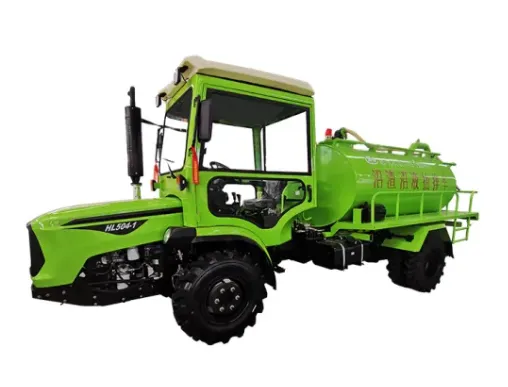Sep. 25, 2024
Tractors are available in four-wheel drive tractors and two-wheel drive, and both drive types have their own advantages and disadvantages. You can choose according to your actual needs. The driving capacity of the tractor is driven by the power of the internal combustion engine through the transmission system, so that the driving wheel obtains the driving torque Mk. The driving wheel that obtains the driving torque applies a small backward horizontal force (tangential force) to the ground through the tire pattern and tire surface, while the ground faces a horizontal force Pk with equal driving force and opposite direction. This Pk reaction force is the driving force (also called propulsion force) that pushes the tractor forward. When the driving force Pk is sufficient to overcome the forward rolling resistance of the front and rear wheels and the traction resistance of the implement, the tractor will move forward. If the driving wheel breaks to the ground, that is, the driving force Pk is equal to zero, it mainly includes the engine, chassis and electrical equipment. The chassis includes the transmission system, steering system, walking system, braking system and working device. The driving wheel can only idle in place, and the tractor cannot run; if the sum of the rolling resistance and the traction resistance is greater than the driving force Pk, the tractor cannot run. It can be seen that the drive of wheeled tractors is achieved by the interaction between the driving wheel and the ground, and the driving force is greater than the sum of rolling resistance and traction resistance. Below we analyze the main factors that affect tractor driving.

Fuel consumption. Four-wheel drive tractors with the same horsepower consume more fuel than two-wheel drive tractors. Since the front wheels of four-wheel drive tractors have relatively high tire patterns, whether working or walking, the friction resistance is higher than that of two-wheel drive with flat patterns. Higher fuel consumption is also normal. Horsepower output. Under the same horsepower model and the same working conditions, the horsepower output loss of four-wheel drive is lower than that of two-wheel drive. Similarly, the working quality of four-wheel drive tractors is better than that of two-wheel drive tractors. Especially in some heavy-load operations such as plowing and deep plowing and some unsatisfactory arable land conditions, the horsepower output ratio of four-wheel drive tractors is higher, and the working effect and efficiency are better. In terms of load, four-wheel drive tractors have more advantages in heavy load. Range of application. Under the same horsepower, four-wheel drive tractors have a wider range of applications. On slopes, flat land, dry land, paddy fields and hilly areas, four-wheel drive tractors will suspend front drives to reduce the difficulty of operation. However, two-wheel drive tractors are not good at handling mud and slopes, which will affect the stability and operation of two-wheel drive tractors. Highway driving and transportation. The comfort and maneuverability of two-wheel drive tractors are better than those of four-wheel drive tractors; similarly, for low-load farm work, two-wheel drive tractors have more advantages in steering comfort and flexibility because the front wheels are not driven.
90
0
0
All Comments (0)
Previous: How to Compare Rubber Conveyor Rollers Prices?
Next: None
Related Articles
If you are interested in sending in a Guest Blogger Submission,welcome to write for us!
Comments